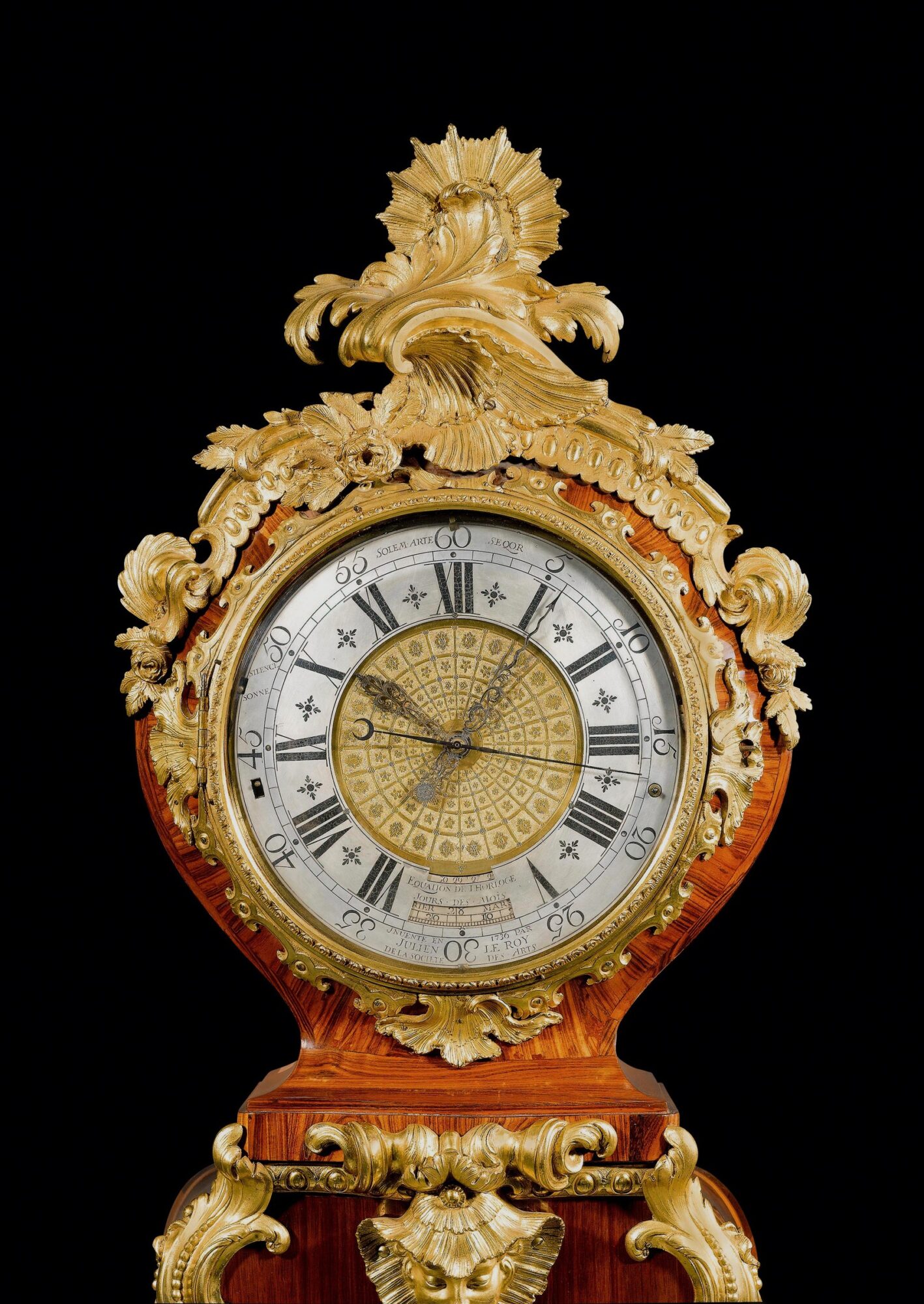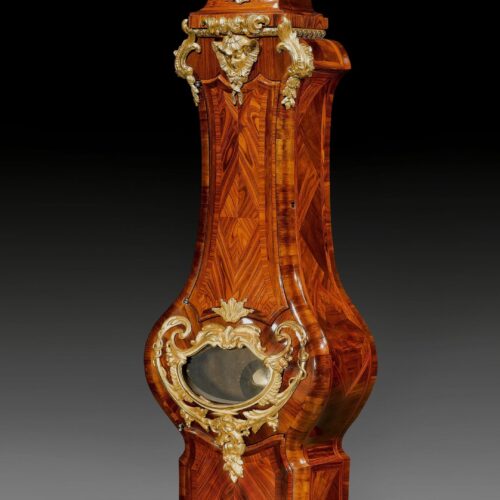Rare and Important Louis XV Regulator Clock

Dial signed by clockmaker Julien Le Roy (1686-1759)
Case attributed to cabinetmaker Charles Cressent (1685-1768)
Paris, Louis XV period, circa 1736-40
Provenance: Baron and Baroness Lopez de Tarragoya, Paris. Sale at Palais Galliera, Paris, 15 June 1971, lot 101 ; Didier Aaron, Paris, 1999.
A very important and rare Louis XV gilt bronze-mounted bois satiné and bois de violette parquetry with case by Charles Cressent and movement by Julien Le Roy, the dial signed “Inventé en 1736 par Julien Le Roy de la Société des Arts”; the movement signed “Julien Le Roy”, bearing a label numbered 5057 987789. The silvered dial ring with Roman and Arabic numerals centred by an elaborately engraved gilt brass circular mask with arrow indicating the equation of time within an aperture at 6 o’clock, marked ‘Equation de l’Horloge’; a calendar aperture marked ‘Jours des Mois’ shows the names of the month and appropriate days for each, with an indicator from below, the main dial with a fine pair of pierced gilt brass hands for the hours and minutes and a blued steel pointer for the sweep centre seconds, with silence/sonne lever to the left of the dial and another small lever below regulating the strike.
The weight-driven grande sonnerie and quarter-striking movement has an unusual Chevalier de Béthune escapement and a steel and brass compensated pendulum. The magnificent violin-shaped case is ornamented with rocaille cartouches and foliate gadroons surmounted by an asymmetrical scallop shell and foliate finial above foliate and rose festoons with further elaborate rocaille mounts around the bezel, the pendulum door headed by a beautiful female mask representing Venus, flanked by foliate angle mounts above a rocaille shell and foliate scrolling cartouche mount incorporating two snakes adorning the glazed pendulum aperture with a further foliate rocaille mount to the splayed base.
Discover our entire collection of rare clocks online or at the gallery.
Two similar regulators, both surmounted by Father Time and with cases by Charles Cressent (one, as here, inlaid with bois de violette and mahogany, with dial signed “Inventé en 1736 par Julien Le Roy”, are illustrated in Cedric Jagger, “Royal Clocks”, 1983, p. 126, pls. 169 and 170. A similar regulator, with case by Charles Cressent, today in the British Royal Collection, is illustrated in Alexandre Pradère, French Furniture Makers, 1989, p. 135, pl. 96. A comparable example, today in the Musée des Arts Décoratifs de Lyon, is illustrated in Olivier Dacade, Musée des Arts Décoratifs de Lyon: Pendules, 1995, pl. 2. The comparable Cressent regulator case with movement by Nicolas Gourdain, in the Musée des Arts Décoratifs de Lyon, is illustrated in Jean-Dominique Augarde, Les Ouvriers du Temps, 1996, p. 330, pl. 249. The present clock, as well as three others, including the example in the Lyon Musée des Arts Décoratifs (cat. 260), one with a movement by Julien Le Roy (cat. 261), sold by Partridge, London, 1991, one now in a private collection (former Marcel Bissey collection, cat. 262), are illustrated in Alexandre Pradère, Charles Cressent Sculpteur, Ebéniste du Régent, 2003, p. 304 (cat. 263), pp. 194-195 and 304-305.
The clock’s case features several references to Venus, the goddess of love. According to legend, Venus was born from the sea and floated to shore on a shell borne by dolphins. When she stepped on shore, the shells she trod on all turned to roses. Thus at the top of the clock we see a scalloped shell motif, below which are roses. Likewise the mask wearing a scallop-shell headdress above the pendulum door is that of Venus. The scallop appears again above the pendulum aperture and in the scrolling gilt bronze cartouche, which also integrates a pair of snakes, symbols of eternity. The clock base features a mount integrating a scallop shell.
Although Cressent made a limited number of regulator cases, the catalogues of the 1757 and 1765 sales of his stock and art collection included several pendules à secondes without movements (nos. 155-156 in 1757 and 97-99 in 1765), the latter two with amaranth veneers. The probate inventory drawn up after Cressent’s death in 1768 mentioned no regulators though it listed several clocks by Hervé and Guiot, with shell and metal or ebony marquetry inlays.
While most of Cressent’s known regulators were veneered in bois satiné and amaranth, one rosewood-veneered example is recorded (Pradère, “Charles Cressent”, cat. 262), others are recorded in ebony (cat. 267); and bois de violette, (the present example and the one in the Musée des Arts Décoratifs de Lyon, cat. 260).
The known models have the same overall shape and similar bronze mounts, including a rocaille cartouche surrounding the glazed pendulum aperture, similar in style to those by Boulle and Berain. Further similar motifs include the rocaille mounts adorning the base. A number of comparable regulators also include beneath the dial a mount showing an allegory of the winds composed of two putti amid clouds (alluding to Venus being blown ashore by the wind), which was inspired by a mount created by Boulle for the Count of Toulouse’s regulator, now in the Musée du Louvre (illustrated in Daniel Alcouffe, Anne Dion Tenenbaum, and Amaury Lefebure, “Le Mobilier du Musée du Louvre”, 1993, vol. I, p. 102-105). The other known Cressent regulators present variations: some are decorated with Chinoiserie masks, which were also used by Cressent (see Pradère, “Charles Cressent”, cat. 188-191). The mask beneath the dial portrays a beautiful female head also present on a Cressent regulator (formerly in the Wallace Collection), and two others with movements signed by Duchesne (cats. 264-266).
The Baron and Baroness Lopez de Tarragoya once owned the present regulator. Much of their exceptional art collection was acquired during the early 20th century through the Parisian dealers Bensimon, L. Kraemer et Fils and Jacques Seligman. Seligman had purchased the majority of the Hertford-Wallace property from 2 rue Lafitte and the Château de Bagatelle in 1914, and numerous items in the Lopez Tarragoya collection came from Sir Richard Wallace’s collection. This is interesting, since a Cressent long case regulator featuring a female mask head mount, like the present piece, is known to have previously been in the Wallace Collection. Thus this clock could also conceivably have come from the Hertford-Wallace Collection. Baron Lopez Tarragoya also bought pieces from the Loewenstein Collection and the Count de Montesquieu.
Julien II Le Roy (1686 - 1759)
Born in Tours, he trained under his father Pierre Le Roy; by the age of thirteen had already made his own clock. In 1699 Julien Le Roy went to Paris where he served his apprenticeship under Le Bon. Received as a maître-horloger in 1713, he later became a juré of his guild; he was also juré of the Société des Arts from 1735 to 1737. In 1739 he was made Horloger Ordinaire du Roi to Louis XV. He was given lodgings in the Louvre but did not occupy them, instead giving them to his son Pierre (1717-85) while continuing to operate his own business from rue de Harlay. Le Roy made important innovations, including the improvement of monumental clocks indicating both mean and true time. Le Roy researched equation movements and advanced pull repeat mechanisms. He adopted George Graham’s cylinder, allowing the construction of thinner watches. He chose his clock cases from the finest makers, including the Caffieris, André-Charles Boulle, Jean-Joseph de Saint-Germain, Robert Osmond, Balthazar Lieutaud, Antoine Foullet and others; his dials were often made by Antoine-Nicolas Martinière, Nicolas Jullien and possibly Elie Barbezat. Le Roy significantly raised the standards of Parisian clockmaking. After he befriended British clockmakers Henry Sully and William Blakey, several excellent English and Dutch makers were introduced into Parisian workshops.
Julien Le Roy’s work can be found among the world’s greatest collections including the Musées du Louvre, Cognacq-Jay, Jacquemart-André and the Petit Palais in Paris. Other examples are housed in the Château de Versailles, the Victoria and Albert Museum and Guildhall in London, Waddesdon Manor, Buckinghamshire, the Musée d’Horlogerie in La Chaux-de-Fonds, the Museum der Zeitmessung Bayer, Zurich, the Rijksmuseum in Amsterdam, the Musées Royaux d’Art et d’Histoire in Brussels, the Museum für Kunsthandwerck, Dresden, the National Museum in Stockholm, the Musea Nacional de Arte Antigua, Lisbon, the J. P. Getty Museum in California; the Walters Art Gallery in Baltimore and the Detroit Institute of Art.
Charles Cressent (1685 - 1768)
Charles Cressent is one of the most important Parisian cabinetmakers of the 18th century, and probably the most famous furniture maker working in the Regence style, which inspired his furniture and sculpture throughout his career. The son of a sculptor to the king, he studied sculpture in Amiens, where his grandfather resided – his grandfather was himself a sculptor and furniture maker. He initially trained as a sculptor and became a member of the Académie de Saint Luc in 1714, presenting a piece in that category. He then settled in Paris and began to work for several of his colleagues, and married the widow of cabinetmaker Joseph Poitou, formerly the cabinetmaker to Duke Philippe d’Orléans, then the Regent. By dint of this marriage, he became head of the workshop and continued its activities so successfully that he, in turn, became the official supplier to the Regent, and upon the Regent’s death in 1723, his son Louis d’Orléans continued to give commissions, thus insuring Cressent’s continued prosperity during those years. His fame quickly spread beyond the kingdom’s frontiers, as several European princes and kings commissioned pieces from Cressent, among them King John V of Portugal and Elector Charles Albert of Bavaria. In France, he had a private clientele that included members of the aristocracy such as the Duke de Richelieu and important collectors, such as the influential Treasurer General of the Navy Marcellin de Selle. Throughout his career, Cressent created his own bronze mounts that were cast in his workshop, which was against the rules of the bronze casters’ guild, as did André-Charles Boulle. This gave his work a great deal of homogeneity and highlighted his extraordinary talents as a sculptor.









